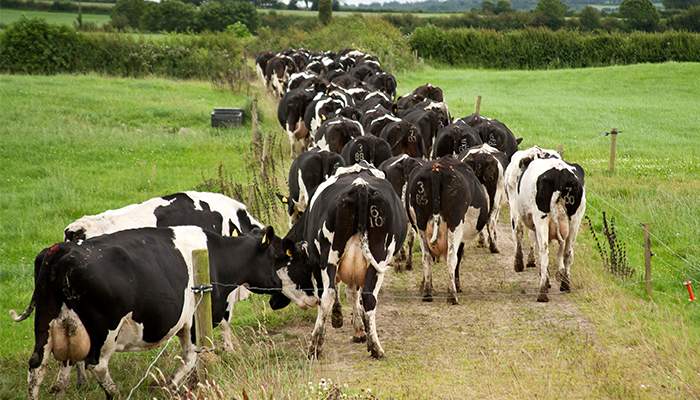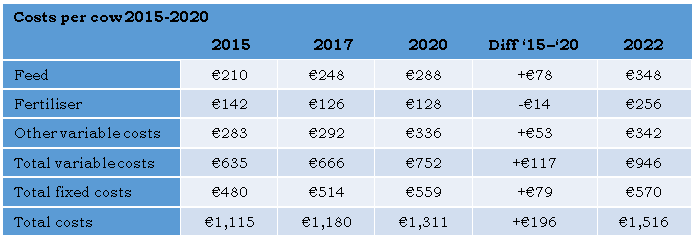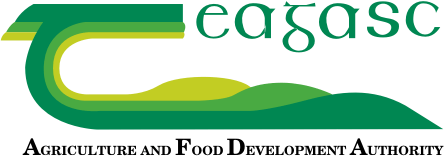29 November 2021
Cost control for 2022

Input costs for dairy farms are projected to increase through early 2022. Although milk price has to some extent masked the impact on margins in the short term, the potential impact is likely to be significant as Patrick Gowing and James Dunne Teagasc, Dairy KT Specialists outline here
As the potential impact across a full production cycle is likely to be significant, it is very important therefore, that dairy farmers complete a physical and financial budget for the coming year. For this paper, we have examined the trends in costs per cow on dairy farms since milk quota abolition in 2015, with a view to identifying potential areas for adjustment.
Trends in costs per cow on dairy farms
In 2015, the average cost to keep a cow on an Irish dairy farm who completed an e-profit monitor was €1,115/cow. For 2017, the average cost per cow increased to €1,180/cow or an average increase of 1.9% over the three years. Increased feed costs per cow accounted for half of the increase. When we look at the period from 2017-2020, the cost per cow increased to €1,311 or a 3.4%/year increase in the period from 2017-2020. There was an increase in all costs with the exception of fertiliser in that period (Table 1). Therefore, over the year year period, the total cost of keeping a dairy cow on the average dairy farm has increased by €196 per year based on these cost categories.
Table 1. Cost analysis per cow for 2015-2020 on spring calving dairy farms

The average level of meal feeding has increased by 200 kg per cow over the five-year period which accounts for €55 of the additional costs. In that period, milk solids (MS) production has increased from 437 kg/cow in 2015 to 476 kg in 2020, an increase of 39 kg MS/cow. The stocking rates on the farms on average have remained relatively static, with additional land added offsetting any increase in cow numbers. The increase in cow performance represents an increase in grass utilised of +0.5t DM/ha over the five years.
What’s projected to happen in 2022?
As we, project forward for 2022 we have assumed no change in the quantity of inputs used but have adjusted the unit cost of feed to €330/t and have assumed a doubling in fertilizer prices over 2020. All other costs are inflated by 1%. This potentially could leave the cost per cow for 2022 at €1,516/cow. That would represent an increase of over €200/cow from 2020, or €20,000 in a 100-cow herd. It would require an increase in milk price of 3.5–4.0c/l on average across the year to offset the increase in costs. Of course, there will be a large farm-to-farm variation in the relative effect of input cost increases, depending on the physical inputs per cow. Herds that are more reliant on purchased feed and fertiliser inputs per unit of milk solids are likely to be impacted to a greater extent.
Considerations for 2022
When looking at cost savings for 2022, it is important to protect the inputs that have a long-term beneficial effect on your business. For example, choosing to cease milk recording next year to save money will reduce herd quality over time, while deciding not to apply lime may have an impact on the total amount of grass grown. Feed and fertiliser will account for 40% of your total running costs for the farm, so practices that improve efficiency in these categories will have the most impact. Changes made to these inputs that result in large reductions in pasture growth and/or cow performance should be avoided however.
In planning ahead for 2022, it is useful to ask the following questions:
Are you grass measuring to make best use of your grass?
Increasing the level of grass utilised through better grazing management could reduce feed required by 10% (100 kg/cow or 0.4 kg/cow/day) and will save €35/cow.
Have you a nutrient management plan in place for 2022?
Make best use of your fertiliser inputs with a targeted nutrient management plan which makes better use of the slurry available on farm through LESS technology. A 10% reduction in fertiliser (or 0.5 bags urea/acre) will save each farm €26/cow.
Are there cows on the farm not paying their way?
Keeping poor performing cows by using additional feed or fertiliser to feed them may not make economic sense. Complete a breakeven analysis on the herd to determine the milk solids yield needed to cover operational costs and make a decision on whether to keep individual cows on that basis. Milk recording reports are an excellent way of identifying ‘passengers’ in the herd.
Is there a fodder budget completed for the farm?
Given the stark increase in projected fertiliser prices coupled with energy price increases, fodder stocks have become more valuable. This needs to be considered before deciding when to sell cull cows, surplus replacement heifers, beef stock etc. Farms should also minimise the level of fodder wastage this winter which can be between 10%-20% in some cases.
Have you a cash flow budget completed for 2022?
Complete a simple cash flow budget for your farm. Be realistic when completing your cash flow budget. Act early where cash flow deficits are identified, consult and draw up a plan with your local Teagasc advisor. Remember budgeting is not an exact science but in most cases a ‘best estimate’ is better than ‘no estimate’. Avoid cutting productive costs when identifying areas where savings can be made.
*All figures used in this analysis are based on spring calving herds from the Teagasc E profit monitor. Data for both variable and fixed costs were used. The figures quoted are for cost categories associated with running a commercial dairy farm business prior to capital repayments, drawings and taxation. Results shown highlight the changes within each category but should not be extrapolated to represent the full economic cost of milk production in these years.
Patrick Gowing, Teagasc Dairy Specialist provides some information and advice in the below clip.
This article was produced as part of the two-day Virtual Dairy Conference 2021 which took place on 23 and 24 November.
The complete Dairy Conference Proceedings can be viewed here and the individual articles will be published on Teagasc Daily throughout the week.
